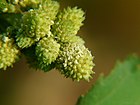Note: This is a project under development. The articles on this wiki are just being initiated and broadly incomplete. You can Help creating new pages.
Xanthium strumarium
Xanthium strumarium is an annual plant that can grow up to 0.75 metres tall. It is harvested from the wild for local use as a food, medicine and source of materials.
Uses
Malaria, Rheumatism, Tuberculosis, Allergic rhinitis, Sinusitis, Catarrh, Rheumatoid arthritis, Constipation, Diarrhoea, Lumbago, Leprosy.[1]
Parts Used
Chemical Composition
The main components of the oil were β-caryophyllene (17.53%), α-cadinol (6.66%), spathulenol (6.09%), limonene (5.66%) and 1,3,5-trimethyl-2[2-nitroallyl]benzene (3.29%) etc.[2]
Common names
| Language | Common name |
|---|---|
| Kannada | ಮರುಳೂಮ್ಮತ್ತಿ Maruluummatti |
| Hindi | Chota dhatura |
| Malayalam | |
| Tamil | Marul-umattai |
| Telugu | Marulutige |
| Marathi | Ghagara |
| Gujarathi | Godrian |
| Punjabi | |
| Kashmiri | |
| Sanskrit | Arishta |
| English | Common Cocklebur, Broad bur |
Properties
Reference: Dravya - Substance, Rasa - Taste, Guna - Qualities, Veerya - Potency, Vipaka - Post-digesion effect, Karma - Pharmacological activity, Prabhava - Therepeutics.
Dravya
Rasa
Guna
Veerya
Vipaka
Karma
Prabhava
Habit
Identification
Leaf
| Kind | Shape | Feature |
|---|---|---|
| Large and broad leaves | Light and bright green in colour in an alternate pattern with irregular lobes |
Flower
| Type | Size | Color and composition | Stamen | More information |
|---|---|---|---|---|
| Numerous | White or green | Male uppermost, Female ovoid, Covered with hooked bristles, Flowering season is August-September | {{{5}}} |
Fruit
| Type | Size | Mass | Appearance | Seeds | More information |
|---|---|---|---|---|---|
| Obovoid | Enclosed in the hardened involucre with 2 hooles beaks and hooked bristle, Fruiting season is August-September |
Other features
List of Ayurvedic medicine in which the herb is used
Where to get the saplings
Mode of Propagation
How to plant/cultivate
Requires a sunny position, succeeding in most soils. Prefers a poor dry soil.[5]
Commonly seen growing in areas
Photo Gallery
References
- ↑ Indian Medicinal Plants by C.P.Khare
- ↑ Chemical constituents
- ↑ Common names
- ↑ Kappatagudda - A Repertoire of Medicianal Plants of Gadag by Yashpal Kshirasagar and Sonal Vrishni, Page No. 396
- ↑ Cultivation
External Links
- Ayurvedic Herbs known to be helpful to treat Malaria
- Ayurvedic Herbs known to be helpful to treat Rheumatism
- Ayurvedic Herbs known to be helpful to treat Tuberculosis
- Ayurvedic Herbs known to be helpful to treat Allergic rhinitis
- Ayurvedic Herbs known to be helpful to treat Sinusitis
- Ayurvedic Herbs known to be helpful to treat Catarrh
- Ayurvedic Herbs known to be helpful to treat Rheumatoid arthritis
- Ayurvedic Herbs known to be helpful to treat Constipation
- Ayurvedic Herbs known to be helpful to treat Diarrhoea
- Ayurvedic Herbs known to be helpful to treat Lumbago
- Ayurvedic Herbs known to be helpful to treat Leprosy
- Herbs with Leaves used in medicine
- Herbs with Young plants used in medicine
- Herbs with Seeds used in medicine
- Herbs with common name in Kannada
- Herbs with common name in Hindi
- Herbs with common name in Tamil
- Herbs with common name in Telugu
- Herbs with common name in Marathi
- Herbs with common name in Gujarathi
- Herbs with common name in Sanskrit
- Herbs with common name in English
- Habit - Annual
- Index of Plants which can be propagated by Seeds
- Herbs that are commonly seen in the region of River banks
- Herbs that are commonly seen in the region of Lake shores
- Herbs that are commonly seen in the region of Cultivated ground
- Herbs










